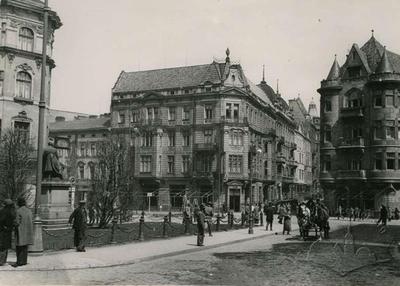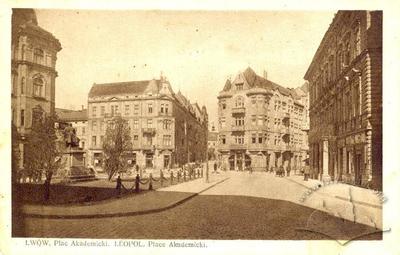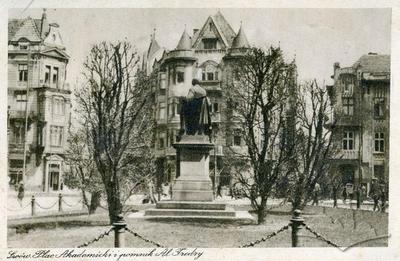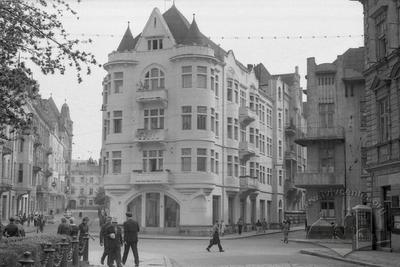Prosp. Shevchenka, 27 – hotel Atlas (former residential building) ID: 2210
This four-storied residential townhouse was constructed in 1909 under a project designed by architect Zbigniew Brochwicz Lewiński for Emil Weksler, an entrepreneur, in the modernized Gothic style. In 1909-1944 the ground floor premises of the house were occupied by the Szkocka (Scottish) coffeehouse where prominent Lviv mathematicians used to gather. The townhouse is an architectural (protection no. 731-M) and historical monument (protection no. 1232).
Story
The townhouse no. 9 on Fredra street – its alternative address is Shevchenka boulevard (earlier Akademicka street) 27 – was built in the place of a small garden which was a part of the territory adjoining a palace which belonged to the Fredro family. The garden bordered on Stizhkova (now Saksahanskoho) street; two streams called the Pasika and the Soroka flowed together at the beginning of this street, thus forming the river Poltva. Once there was a bridge with a statue of St. John of Nepomuk there; the statue was dismantled in the late 19th century. It was then that the garden was also separated from the neighbouring plots.The four-storied residential townhouse was constructed on the eastern side of Akademicka street in 1909 under a project designed by architect Zbigniew Brochwicz Lewiński. The project was commissioned by entrepreneur Emil Weksler who owned the parcel. In 1909-1944 the ground floor of the Weksler’s house was occupied by a coffeehouse called Szkocka (Scottish) which became a place where Lviv mathematicians used to gather. It was in this coffeehouse that Stefan Banach, a prominent representative of the Lviv mathematical school of the 1st half of the 20th century, discovered the functional analysis theory which was later called “the Scottish theory”.
Till the mid-1930s, Lviv mathematicians led by Stefan Banach used to regularly gather in the Roma coffeehouse (now the Akademichne café on Shevchenka boulevard 25). After the Roma owner refused to serve the scientists on credit, the mathematicians’ community moved to the Szkocka coffeehouse located across the street.
While drinking their beer, Banach and his colleagues solved difficult mathematical problems and led discussions. The coffeehouse tables had marble tops, and the visitors used to write equations on them with indelible pencils (waiters had to clean the tables later). It was at the Szkocka that Banach broke records for the speed of solving mathematical problems.
He did not write any notes on paper at first and informed his colleagues about his scientific ideas orally. In 1935 (or in 1933, according to other sources), after his wife bought a big notebook for him, he began to write down his formulae and theorems. The notebook was kept in the coffeehouse. Every day a waiter brought it to the owner and put it back to the hiding place before the closing time. The first entry in this notebook was written on 17 July 1935 and the last one on 31 March 1941.
In 1940 Stefan Banach became the dean of the physical and mathematical faculty of the Lviv University. Records concerning the solutions of 193 mathematical problems can be found in this notebook. 14 problems were written personally by Banach; 40 and 24 by his colleagues Ulam and Mazur, respectively; 40 were solved collectively.
Stefan Banach died in Lviv on 31 August 1945. After his death, the big notebook known as “the Scottish book” was inherited by his son and taken to Wrocław. In 1945-1948 Banach’s followers kept writing in it; however, they entitled their entries “the new Scottish book”. So, the name of a world-famous theoretical work arises from the name of a coffeehouse.
According to the resolution of the Lviv regional executive committee number 330 dated 24 June 1986, the house is an architectural and urban planning monument of local significance under protection number 731-M (Лв); also, it is a historical monument of local significance (resolution of the Lviv regional executive committee number 183 dated 5 May 1972) under protection number 1232.
Architecture
The townhouse is situated at the edge of the block, on a trapezium-shape end parcel. This corner plot borders on Fredra and Gertsena streets and on Shevchenka boulevard. The building’s expressive silhouette accentuates the southern boundary of this boulevard.The four-storied townhouse is built of brick; reinforced concrete was also used in its construction. It has three façades with bays and half towers at the corners. The building is covered with a high roof and has a V-shaped configuration.
The interior planning belongs to the corridor and enfilade type; there are two apartments on each floor. The house can be entered through a narrow lobby with a coffered ceiling.
Modernized Gothic motifs were used in the building’s massive architectural forms by the architect.
People
Stefan Banach – a mathematician, a prominent representative of the Lviv mathematical school.Emil Weksler – the building owner.
Zbigniew Brochwicz Lewiński – an architect.
Stanisław Mazur – a mathematician.
Stanisław Ulam – a mathematician.
Sources
- Архітектура Львова: Час і стилі ХІІІ–ХХІ ст. (Львів: Центр Європи, 2008).
- Arсhitektura Lwowa XIX wieku (Kraków: Międzynarodowe Centrum Kultury, 1997).
- Dawna fotografia lwowska 1839–1939, red. A. Żakowicz (Lwów: Centrum Europy, 2004).
- Lwów: Ilustrowany przewodnik (Lwów: Centrum Europy; Wrocław: Via Nova, 2003).



















